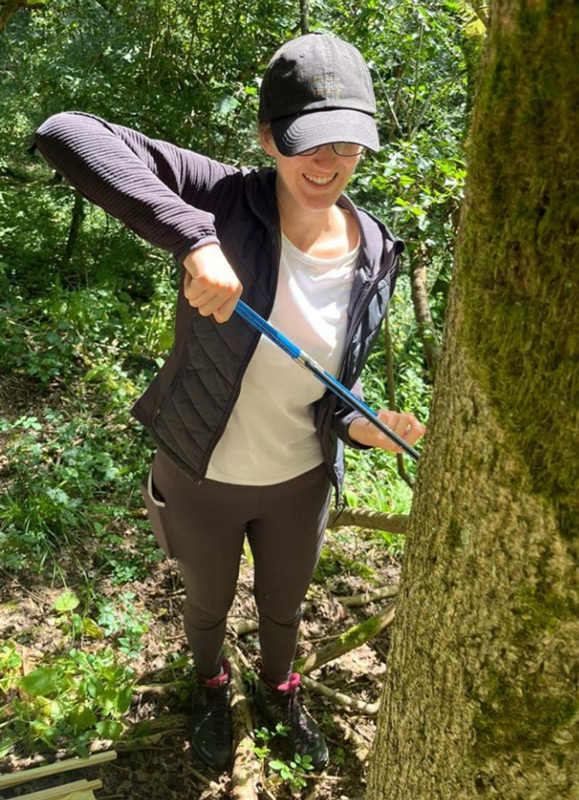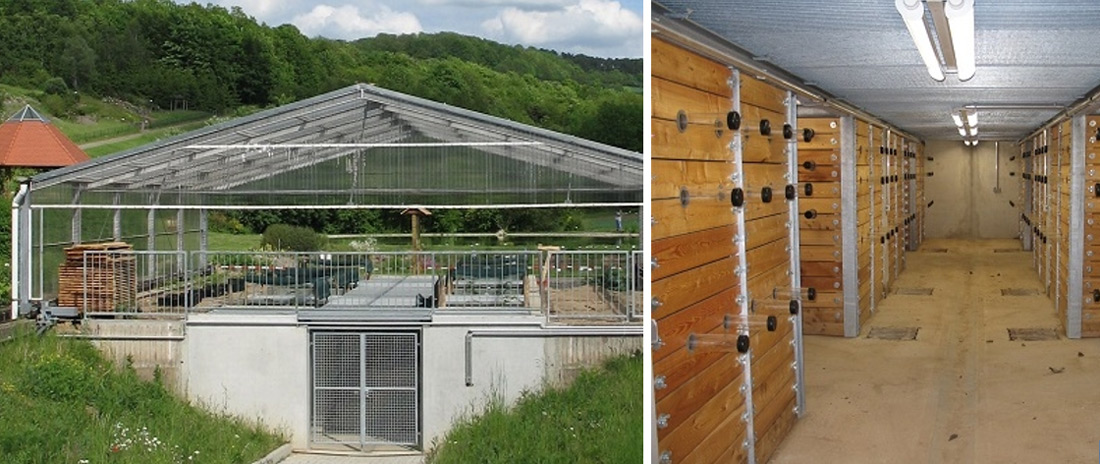Research Projects
- Comparison of climate sensitivity of growth and influence of climate change on tree species in FranconiaHide
-
Comparison of climate sensitivity of growth and influence of climate change on native and non-native tree species in Franconia
Project management: Dr. Lena Muffler-Weigel, Dr. Robert Weigel, PD Dr. Gregor Aas
Forestry faces the significant challenge of maintaining the important functions of our forests despite climate change. This requires a careful review of tree species selection, including non-native species. In order to make sound recommendations for a climate-resilient forest of the future in our region, it is necessary to investigate the effects of various abiotic and biotic stressors on the health and growth of both native and non-native tree species.
At the ÖBG, we conduct dendroecological investigations. By analyzing the annual rings of trees, the impact of past stress events on tree growth can be traced, allowing comparisons between different tree species.
- Attractiveness of peat-reduced growing media for fungus gnatsHide
-
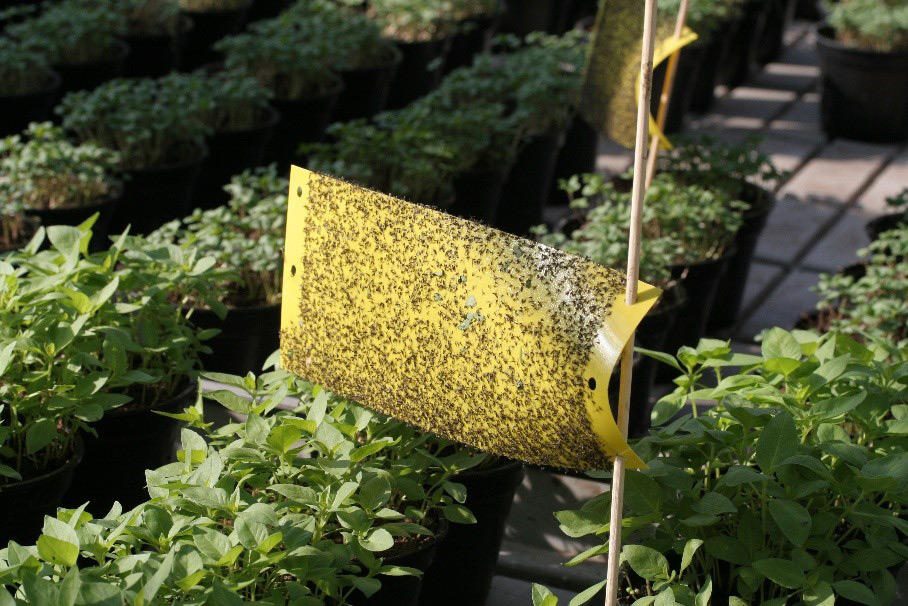
Yellow sticky trap monitoring in a heavily fungus gnat-infested potted herb crop (Photo: HSWT).
Attractiveness of growing media for fungus gnats in organic potted plant cultivation (Project TRAUTOPF)
Project management: Prof. Dr. Elisabeth Obermaier, Prof. Dr. Birgit Zange (Hochschule Weihenstephan-Triesdorf),
Project manager: Andrea Baron, Doktorandin ÖBG, HSWTIn organic potted plant cultivation, the use of peat substitutes containing easily degradable organic material and organic fertilizers often promotes mass reproduction of fungus gnats. Especially in young plant stocks, larval feeding on roots and stems leads to significant losses. Under high infestation pressure, the available control measures (beneficial organisms/neem products) usually do not achieve sufficient success. Therefore, pot trials, scent analyses, and investigations of microbial activity will be conducted to determine why certain substrate components and fertilizers are highly attractive to fungus gnats. Based on this knowledge, criteria for risk assessment of growing media and practical control strategies will be developed.
- Studies on insect diversity on non-native tree speciesHide
-
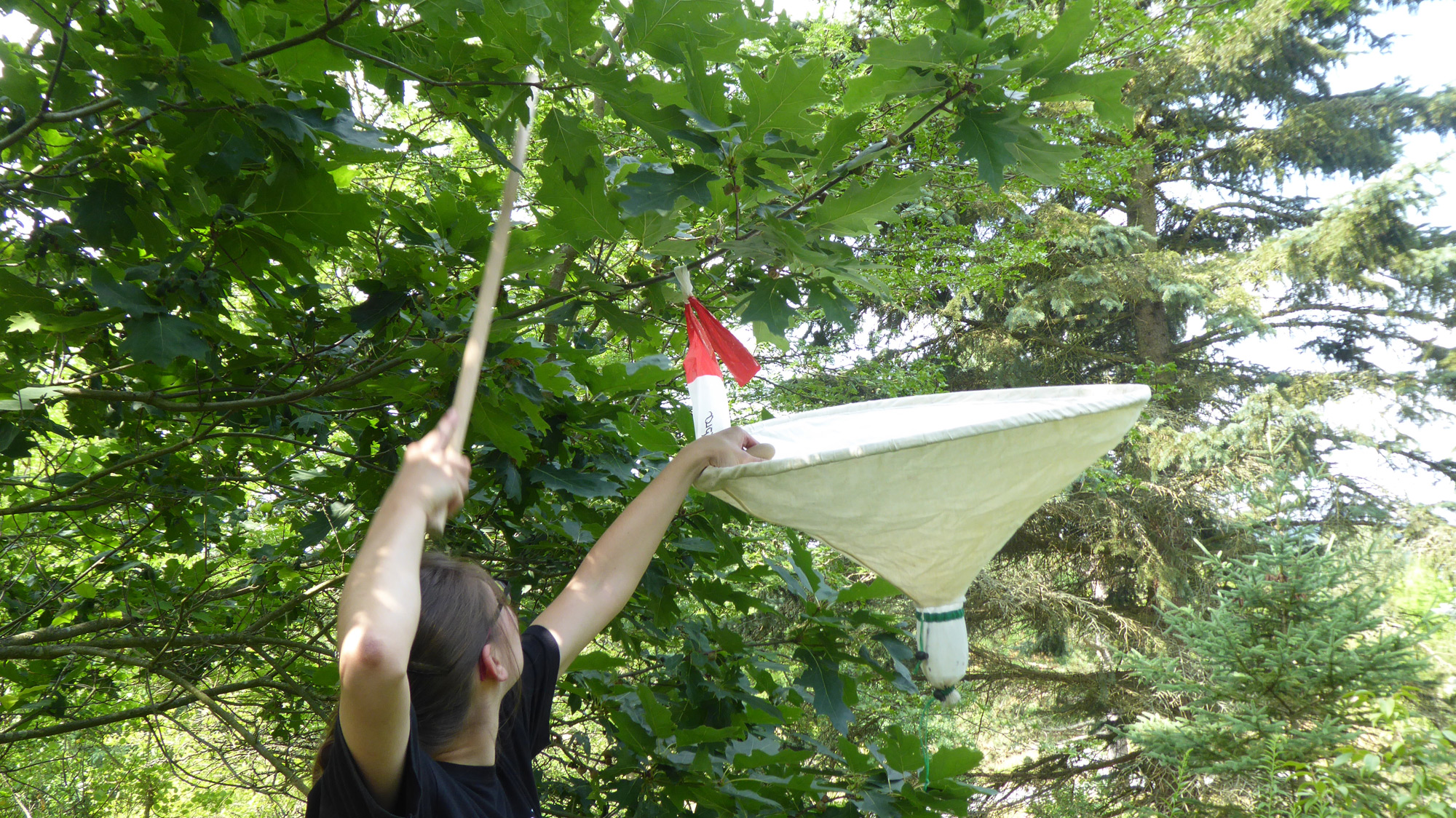
Beating samples on an oak tree. © M. Lauerer
Studies on insect diversity on non-native tree species
Project management: Dr. Marianne Lauerer, Prof. Dr. Elisabeth Obermaier
Against the backdrop of biodiversity conservation and the current use of non-native trees in forests and urban areas due to climate change, it is important to understand to what extent non-native tree species provide food and habitat for native insects.
Oak (Quercus), birch (Betula), maple (Acer), and ash (Fraxinus) species from North America and Asia, as well as from Central Europe (native), are being studied to determine which herbivorous insects are found on their leaves.
Further investigations focus on the diversity of gall-inducing insects as specialists, as well as on analyzing leaf traits and chemical contents.
The findings for the non-native tree species are evaluated (1) in relation to the geographical distance of their native range and (2) in terms of their phylogenetic relatedness to native tree species.
The ÖBG is ideally suited for such a study, as native and non-native species - some more, some less closely related - have been growing side by side under the same conditions for many years (a so-called common garden experiment). - Diversity and ecology of the genus Salix (Willow)Hide
-
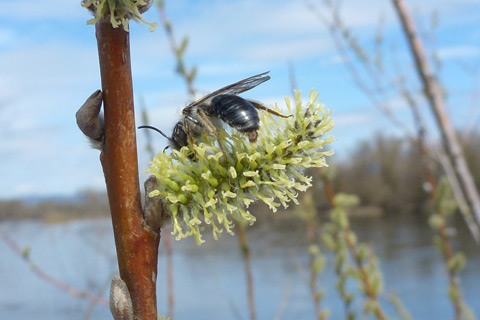
Wild bee on the female inflorescence of the basket willow.
Diversity and ecology of the genus Salix (Willow)
Project management: PD Dr. Gregor Aas
Salix (willow) is the most biodiverse genus of woody plants in Central Europe, of great ecological importance and a key component of many terrestrial habitats. The Ecological Botanical Garden of the University of Bayreuth maintains an extensive collection of Salix species. Research on the numerous willow species present in the ecological botanical garden has, in recent years, led to new insights into morphological and genetic differentiation, reproductive biology, and the significance of willows for insects. These findings are being incorporated into a monographic treatment of Central European Salix species, which is scheduled for publication in 2027.
- Impact of climate change on leaf and root phenology of European deciduous tree speciesHide
-
Impact of climate change on leaf and root phenology of European deciduous tree species
Project managment: Dr. Lena Muffler Weigel
Project manager: Julius Fischer, Doktorand ÖBG, Uni GöttingenGlobal warming is altering tree phenology, which can impact plant fitness and species composition. As temperatures rise, the aboveground growing season is likely to lengthen. However, how root growth responds to increasing temperatures and how root and leaf phenology are interconnected remains largely unexplored.
This project investigates how rising temperatures affect the leaf and root phenology of three deciduous tree species - European beech, silver birch, and sessile oak - and what effects these changes have on tree productivity and the forest carbon cycle.
The project is conducted in cooperation with the University of Göttingen. Experimental work takes place at the Experimental Botanical Garden in Göttingen and in the Göttingen Root Laboratory. - Impact of Climate Change on Forest Health: Winter Cold as an Additional Stress FactorHide
-
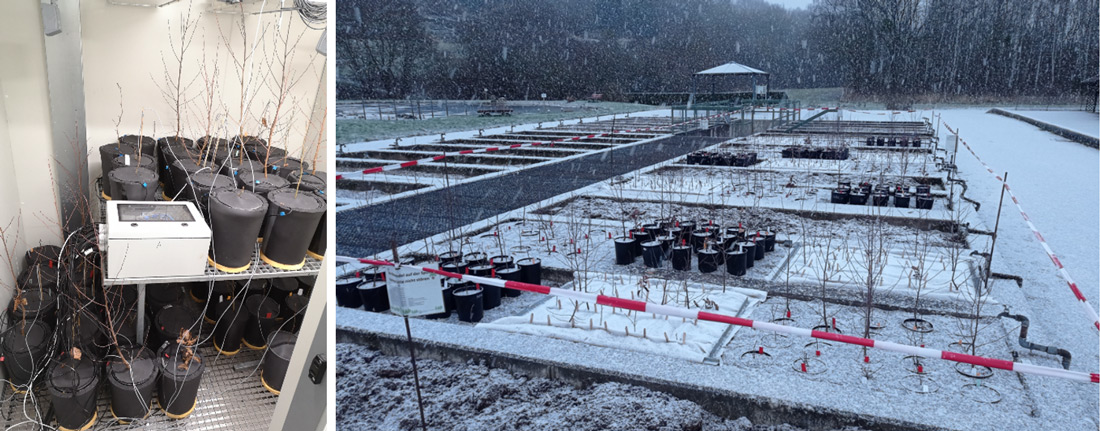

Simulation of different soil frost scenarios in climate chambers and in the field through varying exposure (freestanding and protected by being buried in the ground) and insulation (thermal insulation of buried pots using fleece) of potted young trees.
Impact of Climate Change on Forest Health: Winter Cold as an Additional Stress Factor
Project management: Dr. Robert Weigel
Project manager: Jana Hoppe, Abt. Pflanzenökologie und Ökosystemforschung, Georg-August Universität GöttingenClimate change is increasingly affecting forests worldwide. In addition to summer droughts, winter frost—exacerbated by decreasing snow cover—can also increase fine root mortality and impair tree growth. This project investigates how colder soils in winter act as an additional stress factor for tree species in temperate regions. Through soil frost experiments conducted in a research garden and climate chambers, the effects on European beech, silver birch, and sessile oak are being studied. The goal is to understand the mechanisms of winter cold sensitivity and to assess the potential for adaptation.
- Tree-ring research on southern beeches and exotic conifers in ArgentinaHide
-
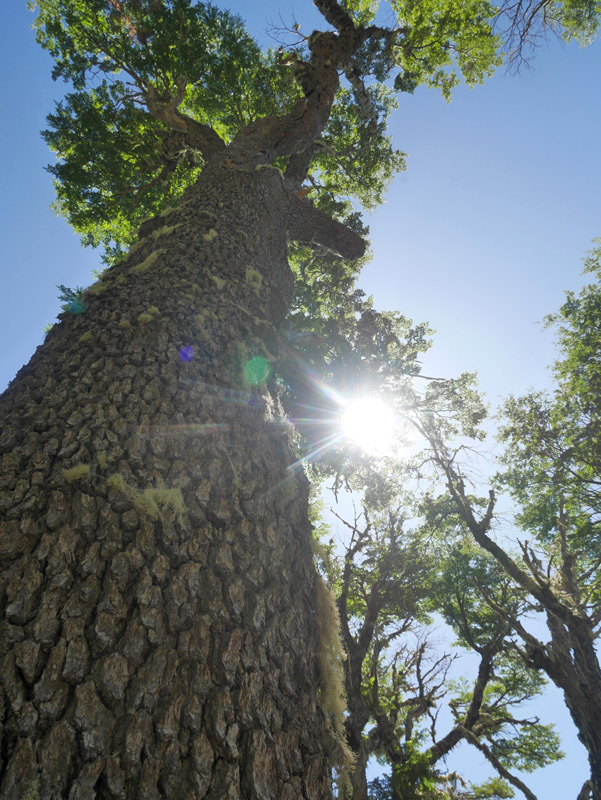

A lenga beech (Nothofagus pumilio) from which core samples were taken to study the impact of climate change on tree growth at the forest line in the Patagonian mountains. Photo: Robert Weigel.
Tree-ring research on southern beeches and exotic conifers in Argentina
Project management: Prof. Dr. Helge Walentowski, HAWK Göttingen, Dr. Robert Weigel (Co-PI)
Project manager: Ernesto Juan ReiterThe project “KLIMNEM” investigates the sustainable management of temperate deciduous forests and aims to compare northern hemisphere beech forests with southern hemisphere Nothofagus forests. A key focus is on tree-ring research on southern beeches (Nothofagus spp.) in Patagonia.
The goal is to understand the adaptation strategies of these tree species to climate change and to develop sustainable forest management strategies. This includes analyzing the effects of extreme events and disturbances on tree growth and comparing them with the growth of introduced North American conifers (e.g., Pinus radiata, P. ponderosa).
The research also encompasses the study of complex interactions between natural events such as wildfires and human influences. - WetWin: Effects of climate change on winter weather and ecosystemsHide
-
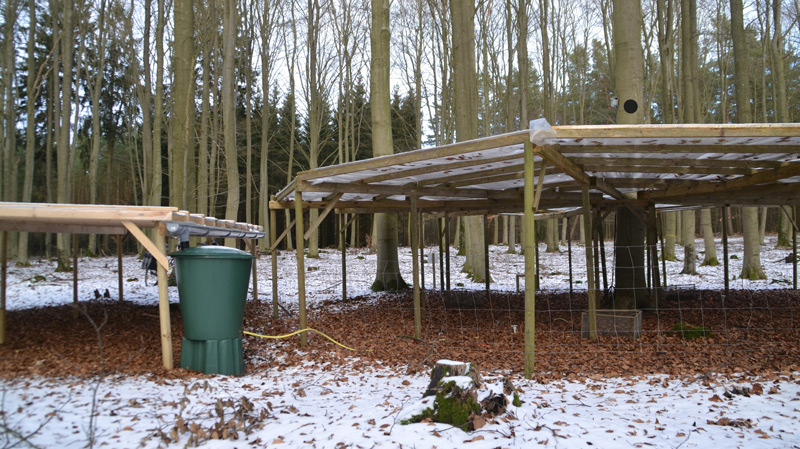

To simulate winter climate change scenarios, snow cover on the forest floor is prevented using a roof structure (visible on the right in the image). The meltwater from this and an additional roof (on the left) is then directed onto the test plot to simulate increased precipitation during thaw periods.
WetWin: Effects of climate change on winter weather and ecosystems
Project management: Prof. Dr. Jürgen Kreyling, Experimentelle Pflanzenökologie, Universität Greifswald, Dr. Robert Weigel (Co-PI)
Project manager: Aron GarthenThe project investigates the effects of winter climate change on beech forests in northeastern Germany and northern Poland. Forecasts indicate that winters will become warmer and wetter, with more rain instead of snow. The increase in precipitation appears to have a long-term positive effect on plant growth, likely due to water storage in deeper soil layers. In contrast, root growth is primarily influenced by soil temperatures.
In regions that have historically experienced heavy snowfall, the absence of a snow cover can lead to colder soil temperatures and negatively affect root growth. It has also been shown that wetter winters result in increased nutrient input on the one hand, but also in greater leaching, so that the amount of plant-available nutrients remains unchanged. - The future of Scots pine in BavariaHide
-
The future of Scots pine in Bavaria
Project management: Dr. Hans-Joachim Klemmt, Bayerische Landesanstalt für Wald und Forstwirtschaft, PD Dr. Gregor Aas, Dr. Robert Weigel
Project manager: Stefanie SpringerScots pine, the second most important forestry tree species in Germany, is increasingly under pressure in its main distribution area in Bavaria, Middle Franconia. As part of the project, Scots pine stands at various sites in northern Bavaria are being examined for a range of influencing factors. A common phenomenon affecting these trees is infestation by pine mistletoe, the extent of which is to be assessed using aerial surveys conducted with unmanned aerial vehicles (UAVs), commonly known as drones.
In addition, the presence of the pathogen Sphaeropsis sapinea, which causes Diplodia tip blight, is being measured on the study plots. In cooperation with the Office for Forest Genetics, needle samples from the crowns of the pines are being analyzed to determine whether genetic differences exist that influence susceptibility or resilience to parasitic infestation. Tree-ring analyses are being conducted to reveal how the mentioned factors affect the growth dynamics of the trees.


